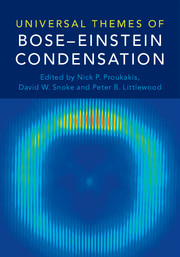Foreword
Published online by Cambridge University Press: 18 May 2017
Summary
At the time of the first workshop in this series in 1993, the only experimentally realized Bose condensate (at least in the simple sense conjectured by Einstein) was liquid 4He. In the intervening twenty-plus years, much has happened in the world of Bose-Einstein condensation (BEC). Probably the most exciting development has been the attainment of condensation in ultracold bosonic atomic gases such as 87Rb and 23Na in 1995, followed a few years later by the achievement of degeneracy and eventually Bardeen-Cooper-Schrieffer (BCS) pairing in their fermionic counterparts, and the experimental realization of the theoretically long-anticipated “BEC-BCS crossover” by using the magnetic field degree of freedom to tune the system through a Feshbach resonance. One particularly fascinating aspect of the latter has been the realization of a “unitary gas” at the resonance itself – a system which prima facie has no characteristic length scale other than the interparticle separation, and is therefore a major challenge to theorists. Other systems in which BEC has been realized, sometimes transiently, include exciton-polariton complexes in semiconducting microcavities and, at least in a formal sense, the magnons in a magnetic insulator, as well as ultracold gases with a nontrivial and sometimes large “spin” degree of freedom.
As compared with our “traditional” Bose condensate, liquid 4He, these new systems typically have many more (and more rapidly adjustable) control parameters, and have therefore permitted qualitatively new types of experiment. One particularly fascinating development has been the use of optical techniques to generate “synthetic gauge fields” and thus mimic some of the topologically nontrivial systems which have recently been of such intense interest in a condensed-matter setting. At the same time, there remain long-standing issues from helium physics, such as the nature and consequences of “spontaneously broken U(1) symmetry,” the “Kibble-Zurek” mechanism, and more generally the relaxation of strongly nonequilibrium states to equilibrium; in some cases, the new systems have been used to address these more quantitatively than was possible with 4He. The chapters in this volume address all of these questions and more, and should be of intense interest to both the experimental and the theoretical sides of the BEC community.
- Type
- Chapter
- Information
- Universal Themes of Bose-Einstein Condensation , pp. viii - xPublisher: Cambridge University PressPrint publication year: 2017



